Related Research Articles
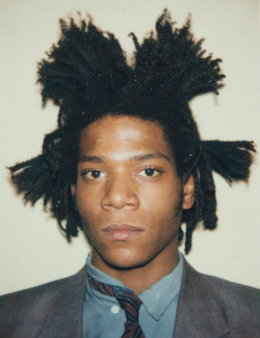
Jean-Michel Basquiat was an American artist who rose to success during the 1980s as part of the Neo-expressionism movement.

Fred Brathwaite, more popularly known as Fab 5 Freddy, is an American visual artist, filmmaker, and hip hop pioneer. He is considered one of the architects of the street art movement. Freddy emerged in New York's downtown underground creative scene in the late 1970s as a graffiti artist. He was the bridge between the burgeoning uptown rap scene and the downtown No Wave art scene. He gained wider recognition in 1981 when Debbie Harry rapped on the Blondie song "Rapture" that "Fab 5 Freddy told me everybody's fly." In the late 1980s, Freddy became the first host of the groundbreaking hip-hop music video show Yo! MTV Raps.

Leonard Hilton McGurr, known as Futura, and formerly known as Futura 2000, is an American contemporary artist and former graffiti artist.
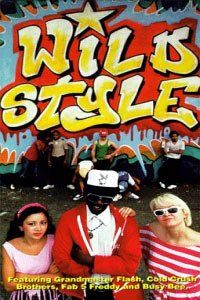
Wild Style is a 1983 American hip hop film directed and produced by Charlie Ahearn. Regarded as the first hip hop motion picture, it includes appearances by seminal figures such as Adam Horowitz Fab Five Freddy, Lee Quiñones, Lady Pink, The Rock Steady Crew, The Cold Crush Brothers, Rammellzee with Shockdell, Queen Lisa Lee of Zulu Nation, Grandmaster Flash, and ZEPHYR.

Downtown 81 is a 2000 American film that was shot in 1980-1981. The film was directed by Edo Bertoglio and written and produced by Glenn O'Brien and Patrick Montgomery, with post-production in 1999-2000 by Glenn O'Brien and Maripol. It is a rare real-life snapshot of an ultra-hip subculture of post-punk era Manhattan. Starring renowned artist Jean-Michel Basquiat and featuring such East Village artists as James Chance, Amos Poe, Walter Steding, Tav Falco and Elliott Murphy, the film is a bizarre elliptical urban fairy tale. In 1999, Michael Zilkha, founder of ZE Records, became the film's executive producer.

ZEPHYR, born Andrew Witten, is a graffiti artist, lecturer and author from New York City. He began writing graffiti in 1975 using the name "Zephyr" in 1977. He is considered a graffiti "elder", who along with Futura 2000, Blade, PHASE 2, CASH, Lady Pink and TAKI 183 invented styles and standards which are still in use.
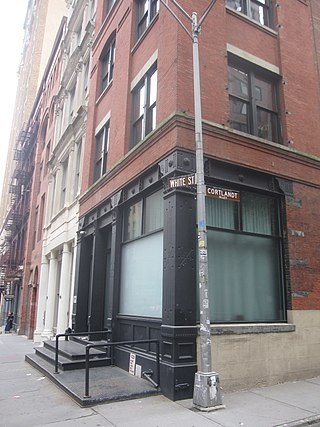
The Mudd Club was a nightclub located at 77 White Street in the TriBeCa neighborhood of Lower Manhattan in New York City. It operated from 1978 to 1983 as a venue for post punk underground music and no wave counterculture events. It was opened by Steve Mass, Diego Cortez and Anya Phillips.
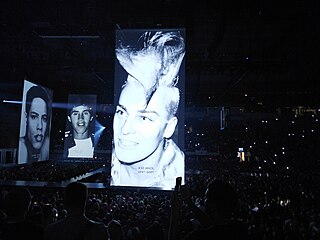
John McLoughlin, better known by the stage name John Sex, was an American cabaret singer and performance artist in New York City from the late 1970s until his death in late 1990.

Kenny Scharf is an American painter known for his participation in New York City's interdisciplinary East Village art scene during the 1980s, alongside Jean-Michel Basquiat and Keith Haring. Scharf's do-it-yourself practice spanned painting, sculpture, fashion, video, performance art, and street art. Growing up in post-World War II Southern California, Scharf was fascinated by television and the futuristic promise of modern design. His works often include pop culture icons, such as the Flintstones and the Jetsons, or caricatures of middle-class Americans in an apocalyptic science fiction setting.
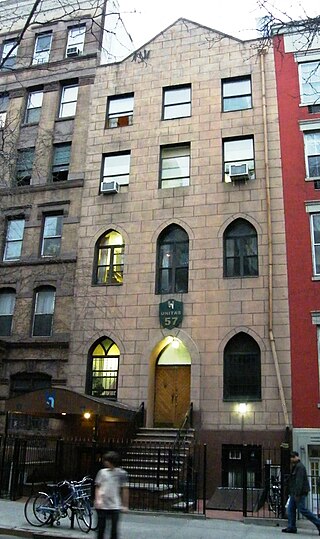
Club 57 was a nightclub located at 57 St. Mark's Place in the East Village, New York City during the late 1970s and early 1980s. It was originally founded by Stanley Zbigniew Strychacki as well as Dominic Rose, then enhanced by nightclub performer Ann Magnuson, Susan Hannaford, and poet Tom Scully. It was a hangout and venue for performance and visual artists and musicians, including The Cramps, Madonna, Keith Haring, Cyndi Lauper, Charles Busch, Klaus Nomi, The B-52s, RuPaul, Futura 2000, Tron von Hollywood, Kenny Scharf, Frank Holliday, John Sex, Wendy Wild, The Fall, April Palmieri, Peter Kwaloff, Robert Carrithers, The Fleshtones, The Fuzztones, Joey Arias, Lypsinka, Michael Musto, Marc Shaiman, Scott Wittman, Fab Five Freddy, Jacek Tylicki, and to a lesser extent, Jean-Michel Basquiat.
Edo Bertoglio is a Swiss photographer, film director and screenwriter. He is the director of Downtown 81 and Face Addict.

Donald Joseph White, "DONDI" was an American graffiti artist.
Michael Thomas Holman is a New York-based artist, writer, filmmaker and musician. He is also an early 1980s downtown scene subculturalist and creator of the Hip Hop music program Graffiti Rock. Holman is a founding member, along with Jean-Michel Basquiat, of the experimental band Gray.

Patricia Titchener, known by her stage name Patti Astor, was an American performer who was a key actress in New York City underground No Wave films of the late-1970s. Astor was a key player in the East Village art scene of the early-1980s as she co-founded the instrumental contemporary art gallery, Fun Gallery. Astor also was involved in the early popularizing of hip hop with her performance in Wild Style.
SAMO is a graffiti tag originally used on the streets of New York City from 1978 to 1980. The tag, written with a copyright symbol as "SAMO©", and pronounced Same-Oh, is primarily associated with the artist Jean-Michel Basquiat, but was originally developed as a collaboration between Basquiat and Al Diaz.

James Allan Curtis, known professionally as Diego Cortez, was an American filmmaker and art curator closely associated with the no wave period in New York City. Cortez was the co-founder of the Mudd Club, and he curated the influential post-punk art show New York/New Wave, which brought the then aspiring artist Jean-Michel Basquiat to fame.

Robert Hawkins is an American artist born in Sunnyvale, California, USA and presently lives in London, UK., Hawkins' is best known for his "ferocious" style of realism. His first drawing in a publication appeared in the kid's section of the San Francisco Chronicle at the age of 5.

A Pile of Crowns for Jean-Michel Basquiat is a 1988 painting created by American artist Keith Haring. The artwork was made to memorialize his friend, artist Jean-Michel Basquiat. It depicts a towering pile of Basquiat's trademark crowns.

The Times Square Show was an influential collaborative, self-curated, and self-generated art exhibition held by New York artists' group Colab in Times Square in a shuttered massage parlor at 201 W. 41st and 7th Avenue during the entire month of June in 1980. The Times Square Show was largely inspired by the more radical Colab show The Real Estate Show, but unlike it, was open 24 hours a day, 7 days a week, in what was then a Times Square full of porno theaters, peep shows, and red light establishments. In addition to experimental painting and sculpture, the exhibition incorporated music, fashion, and an ambitious program of performance and video. For many artists the exhibition served as a forum for the exchange of ideas, a testing-ground for social-directed figurative work in progress, and a catalyst for exploring new political-artistic directions.
New York/New Wave was an exhibition curated by Diego Cortez in 1981. Held at the Long Island City gallery P.S.1, it documented the crossover between the downtown art and music scenes. The show featured a coalition of No wave musicians, painters, graffiti artists, poets, and photographers.
References
- 1 2 3 Hixon, Michael (June 5, 2018). "Patti Astor revives New York's Fun Gallery in Hermosa Beach". The Beach Reporter. Retrieved 2020-10-06.
- ↑ "When Graffiti Paintings Sell for Thousands, the Art World Sees the Writing on the Wall". People Magazine. August 22, 1983.
- 1 2 "A little FUN Gallery with Patti Astor". Village Preservation. July 10, 2019. Retrieved 2020-10-06.
- 1 2 "'Queen of the Downtown Scene': Interview with Patti Astor, former co-owner of FUN Gallery". Artsy. March 3, 2014. Retrieved 2020-10-06.
- ↑ https://artinthestreets.org/text/fun-gallery-text
- 1 2 Fensterstock, Ann (2013). Art on the Block: Tracking the New York Art World from SoHo to the Bowery, Bushwick and Beyond. St. Martin's Publishing Group. p. 104. ISBN 978-1-137-36473-9.
- ↑ https://artinthestreets.org/text/fun-gallery-text
- ↑ "Basquiat and His Contemporaries: Exhibition Timeline". Museum of Fine Arts, Boston. Retrieved 2021-10-25.
- 1 2 Hoban, Phoebe (1998). Basquiat: A Quick Killing In Art. Oliver Wendell Holmes Library Phillips Academy. New York: Viking. pp. 138–139. ISBN 978-0-670-85477-6.
- ↑ Pearlman, Alison (2003). Unpackaging Art of the 1980s. University of Chicago Press. p. 184. ISBN 978-0-226-65145-3.
- ↑ Friedman, Vanessa (2021-09-01). "The Mystery of That Basquiat Painting — and Its Tiffany Blue". The New York Times. ISSN 0362-4331 . Retrieved 2021-11-22.
- ↑ Gruen, John (1992). Keith Haring: The Authorized Biography. Simon and Schuster. p. 91. ISBN 978-0-671-78150-7.
- ↑ Schilling, Mary Kaye (October 9, 2013). "Patti Astor, Eighties Art-Scene Icon And Wild Style Star, Still Has Fun". Vulture. Retrieved 2020-10-06.
- ↑ "Fun Gallery… the TRUE Story". Obey Giant. December 20, 2013. Retrieved 2020-10-06.